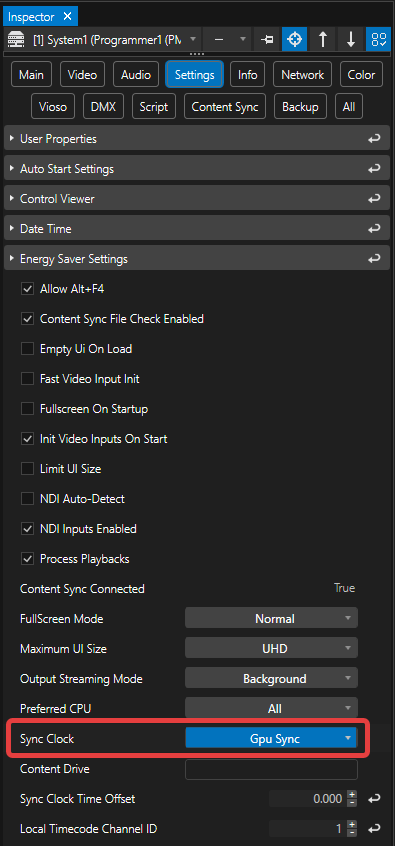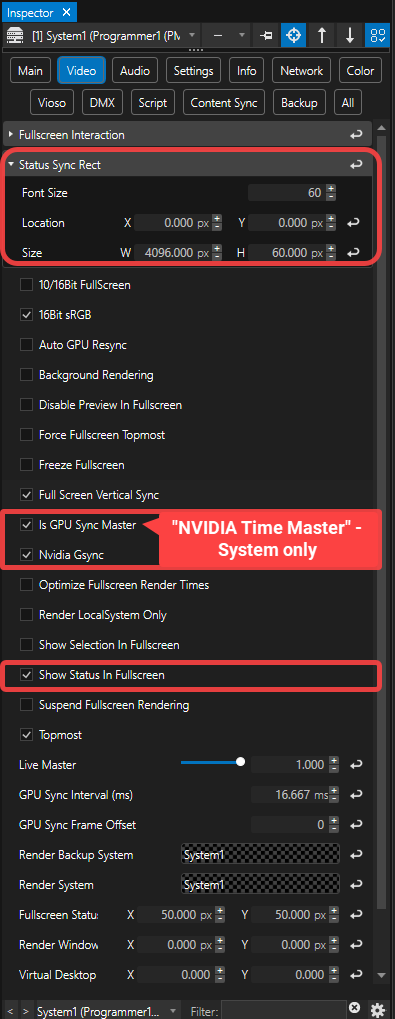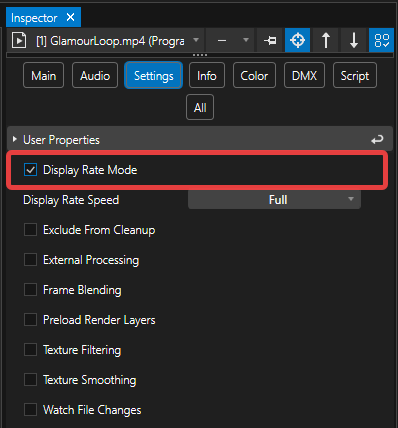•For synchronized playout of media across multiple systems it is mandatory to precisely align their display rates and to force all GPUs to generate their frames at a coordinated time.
•VERTEX fully supports NVIDIA GPU synchronization by utilizing NVIDIAs frame counter as an optional VERTEX Systems Sync Clock source. Hence, GPU sync does not synchronize on hardware level only.
•The interface to NVIDIAs API ensures that textures on multiple VERTEX instances are generated at the same rate on all systems.
•As NVIDIA Quadro Sync II cards also support external references / house sync (“Genlock”) as their clock source, VERTEX is also able to connect to these reference signals.
The procedures described in this manual summarize some complex third-party topics. We recommend to additionally study these documents/pages for deeper insights and troubleshooting advice:
NVIDIA Quadro Sync II Card Setup:
https://www.nvidia.com/content/dam/en-zz/Solutions/design-visualization/quadro-product-literature/du-08348-001_v03.pdf
NVIDIA EDID Emulation:
https://nvidia.custhelp.com/app/answers/detail/a_id/3569/~/managing-a-display-edid-on-windows
NVIDIA MOSAIC setup:
https://nvidia.custhelp.com/app/answers/detail/a_id/3568/~/how-to-setup-mosaic-using-nvidia-control-panel
Requirements
•Systems equipped NVIDIA Quadro RTX GPU.
•NVIDIA Quadro Sync II Card installed in each System that needs to playout in sync.
Note: The master system does not necessarily need to have a Sync Board neither a Quadro RTX GPU if it is not playing out any video. Only if you need to apply the Master role to an actively rendering System that is part of a synchronized playout, this System needs to be part of the NVIDIA Sync Group and a Quadro RTX card and Sync Board is required.
•Optional: external House Sync source / reference generator (genlock).
Hardware Setup
Install the Quadro RTX GPUs and Quadro Sync II Cards on your mainboards PCIe ports. Connect all systems GPUs that need to be synchronized to any available GPU Connector of your Quadro Sync II Card using the NVIDIA Sync Cables.
It is important to provide the same resolution and display rate (most likely even the same EDID) for every Systems GPU output. If different resolutions/EDIDs are involved, make sure to isolate these to dedicated Systems, each hosting only one type of EDID.
•If running different EDIDs on one GPU, setting up a NVIDIA Mosaic will not be possible anymore which impacts both performance and synchronization.
•If running different EDIDs on one system, though grouped together on dedicated GPUs, setting up a single NVIDIA Mosaic will not be possible anymore which impacts both performance and synchronization.
We recommend disabling additional GUI GPUs as well as all mainboard display outputs prior to NVIDIA and VERTEX setup in order to avoid complications during setup and runtime. If additional GUI outputs are needed, please try enabling them after successful setup and perform an in-depth before-after analysis of the Vertex systems rendering performance. Disable additional outputs if the performance decreased.
Note: ensure all NVIDIA Quadro GPUs are installed in x16 PCIe ports of your mainboard. Check whether your CPU/Mainboard supports the required quantity of total PCI lanes to unlock the required performance of the system.
Cabling
After setting up the individual Systems, establish a physical connection between all systems of your cluster:
▪One system needs to be set up as “Frame Lock Master” / “Timing Master”.
▪Start your signal chain from the timing master: connect a CAT 5 cable between the Frame Lock connectors on the timing master and a client machine.
It does not matter which connector you use. Both RJ45 ports on the Quadro Sync Board can be in- or output. It is recommended to create two signal chains off the timing master.
▪Daisy chain all Clients.
▪Do not connect the Quadro Sync II cards to TCP/IP networking equipment. Although it’s the same cable, damages can occur to both the Quadro Sync II cards as well as to networking equipment.

Note: If an external reference is used, connect the cable (BNC connector) to the Timing Masters Quadro Sync II card.
▪The state of the port is indicated by a Small LED on the port:

NVIDIA Setup
Make sure to install the same NVIDIA Quadro RTX display driver on all systems. Vertex usually works best with the latest stable releases.
1.EDID Emulation: Load Display EDIDs for all connected displays in System Topology Menu.
2.Mosaic Setup: Create a single Mosaic with all displays aligned horizontally.
3.Reboot System to ensure NVIDIA driver kept all settings.
4.Synchronize Displays
a.Start with the Timing Server Master. Choose the time server is “On this system” (edit Settings to configure external reference) and apply.
b.Continue with all Client Systems. Choose the time server is “On another system”, select the Mosaic Display to lock to the time servers clock and apply.
VERTEX Setup
Once the NVIDIA GPU sync setup is done, launch VERTEX on all systems and connect to your session.
The following steps can be performed by any system in the session (Suite or EDIT license), regardless of the availability of a Quadro Sync II card.
Go to Project Settings > Sync > Sync Clock Source System... |
... and set it to the particular system configured as your NVIDIA Time Master. |
|
Go to System Settings...
...for systems with a Quadro Sync II |
set Sync Clock to Gpu Sync. These systems will use the hardware-synchronized NVIDIA frame counter as their sync source. |
|
... for systems without a Quadro Sync II |
set Sync Clock to System Clock. These systems (e.g. operators' laptop, editing system etc.) will receive a VERTEX generated clock signal from the Sync Clock Source System through the network.
|
|
Go to System Settings > Video ...
...for systems with a Quadro Sync II |
enable the property Is GPU Sync Master only for the particular VERTEX System that is your dedicated NVIDIA Time Master. Also, enable the property Nvidia Gsync on all synchronized systems.
|
|
For testing purposes |
enable Show Status in Fullscreen on all synchronized Systems.
This will embed synchronization information on the systems fullscreen rendering outputs. Set Size and Location in the property group called Status Sync Rect. Once testing has been satisfactory, you can disable Show Status in Fullscreen and may proceed to play out media. |
|
optional setting for content produced in the systems' display rate |
enable Display Rate Mode to force VERTEX to play out every video frame exactly in synch with the GPU frame cycle. |




